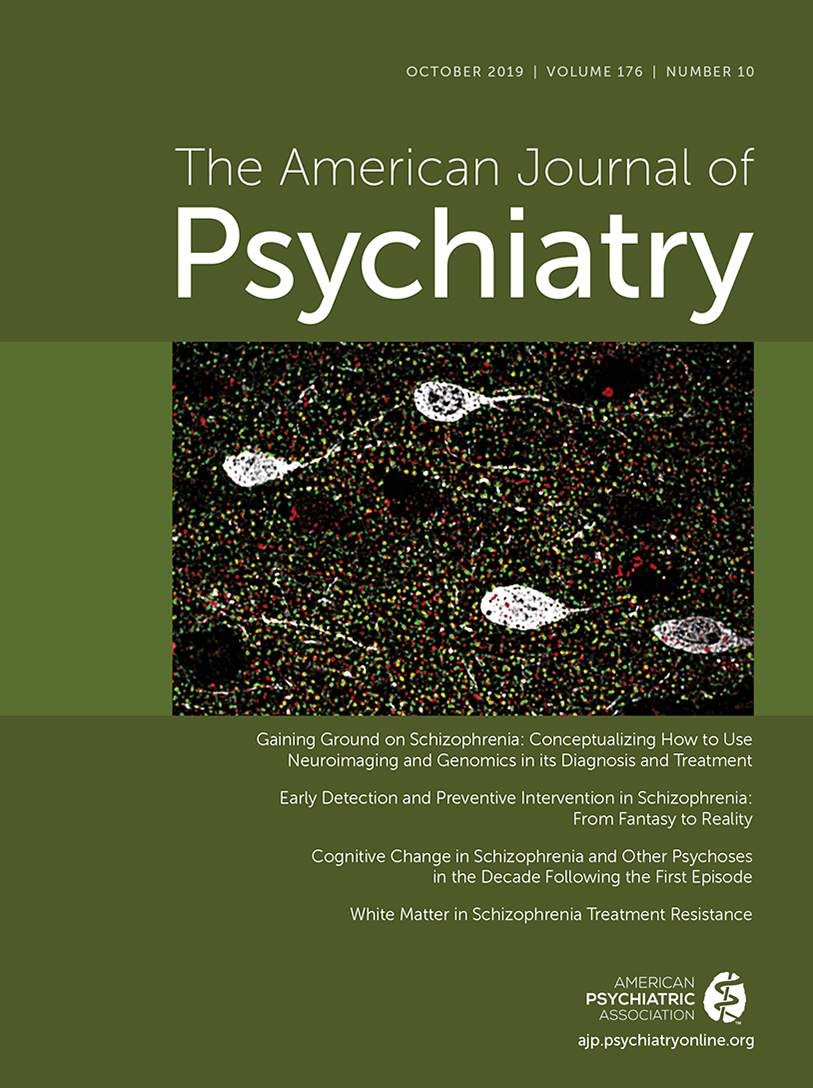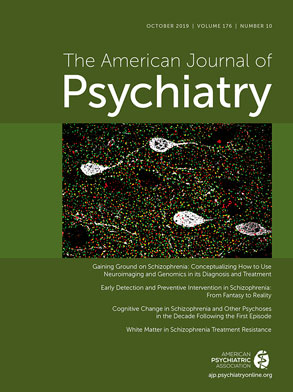T
o the E
ditor: We read with interest Dr. Schatzberg’s commentary (
1), published in the June 2019 issue of the
Journal, on our article reporting the efficacy and safety of esketamine nasal spray combined with a newly initiated oral antidepressant in treatment-resistant depression (
2). We appreciate the thoughtful questions raised about esketamine’s efficacy, safety, and mechanism and here provide clarification regarding these clinically important issues.
Dr. Schatzberg commented that the antidepressant effect size of 0.30 was modest and queried whether efficacy was demonstrated. A crucial point in interpreting this effect size is that the placebo (saline) nasal spray was not administered alone but in combination with a newly initiated oral antidepressant, selected for each participant as one that had not previously failed for the participant. Use of an active control arm likely decreased the difference in improvement between the experimental and control arms because patients in the control arm may have benefited from the newly added antidepressant and every patient knew they would receive an active treatment, increasing the expectation of improvement (placebo effect). This design element may partly explain why the effect size was smaller than that observed in our phase 2 trial, in which esketamine nasal spray was compared with placebo nasal spray by adding each to a previously failed oral antidepressant (
3). Our study (
2) thus constitutes the first head-to-head trial in which a novel antidepressant proved significantly more effective than a newly added conventional antidepressant. The between-group mean difference of 4.0 on the Montgomery-Åsberg Depression Rating Scale at endpoint (day 28) is clinically meaningful and exceeds that reported for most previously approved antidepressant monotherapies or adjunctive therapies for major depressive disorder (
4). The remission and response rates among esketamine-treated patients and the number needed to treat (5 and 6, respectively), as compared with a new antidepressant, are among the most favorable reported in the psychiatric literature.
Regarding maintenance of benefit, Dr. Schatzberg asked whether patients with treatment-resistant depression would achieve full therapeutic benefit by using esketamine at a lower frequency across a shorter time interval, and he questioned the rationale for the maintenance regimen described in the package insert (“twice-weekly administration for 4 weeks, once weekly for 4 weeks, and then, beyond 8 weeks, once weekly or once every 2 weeks”). The present trial tested only the first 4 weeks of this regimen, and shorter treatment periods were not tested. The relationship between treatment duration and persistence of benefit for esketamine appears consistent with data reported for other antidepressants (
5). Thus, Janssen developed a regimen that could maintain esketamine’s antidepressant effect in patients with treatment-resistant depression following a 4-week “induction” period (
2) and a subsequent “optimization-maintenance” phase in which the treatment frequency was reduced and individualized across an additional 12 weeks (total of 16 weeks) (
3,
6). The persistence of the antidepressant response produced by this regimen was tested using a randomized withdrawal design in which the efficacy of maintaining intermittently dosed esketamine plus a newly initiated oral antidepressant was compared with that of maintaining the oral antidepressant plus placebo nasal spray (
6). The relapse rate was significantly lower for patients randomly assigned to continue esketamine plus a newly initiated oral antidepressant.
Referring to the randomized withdrawal study (
6), Dr. Schatzberg observed that patients randomly assigned to switch from esketamine plus a newly initiated oral antidepressant to the oral antidepressant plus placebo nasal spray showed relapse in as early as 2 weeks, with a relapse rate that reached 40% by 3–4 months. He added that this was a shorter time frame than that reported by discontinuation studies of approved oral antidepressants. Critical to interpretation of these findings, however, is the difference in study populations: the discontinuation studies of previously approved antidepressants enrolled patients from the general major depressive disorder population, whereas Daly et al. (
6) studied patients with treatment-resistant depression. Thus, our results are in line with relapse rates seen in the Sequenced Treatment Alternatives to Relieve Depression (STAR*D) study in Levels 3 and 4 (
7), where relapse rates following the 12- to 14-week acute treatment phase were 64.6% and 71.1% with mean times to relapse of 3.1 and 3.3 months, respectively, even while patients continued the same treatment to which they had responded. Thus, in patients with treatment-resistant depression, the relapse rates observed after treatment with esketamine plus a newly initiated oral antidepressant was replaced by treatment with the oral antidepressant plus placebo nasal spray resemble those reported during maintenance treatment with an oral antidepressant alone.
Citing Williams et al., Dr. Schatzberg commented that the acute antidepressant effect of ketamine (0.5 mg/kg i.v.) was attenuated by pretreatment with oral naltrexone, a mu and kappa opioid receptor antagonist, and stated that these results in seven patients suggest that esketamine’s initial, rapid antidepressant effects may depend, at least partly, on the release of endogenous opioids or direct binding to mu opioid receptors. Other authors have commented on the design and interpretation of this study (
8–
10). We would add to this discussion, however, that the exposures achieved during administration of esketamine in the antidepressant dose range are too low to produce direct activation of mu opioid receptors. The inhibitory constant values for ketamine and esketamine binding to
N-methyl-
d-aspartate receptors (approximately 1 μM and 0.5 μM, respectively [
11]), and the corresponding inhibitory constant values for the human mu opioid receptor (42.1 μM and 28.6 μM, respectively [
11,
12]), reflect a much weaker potency. In contrast, the estimated mean unbound levels in the brain are approximately 1 μM for ketamine when administered at the antidepressant dosage of 0.5 mg/kg (
11,
13) and approximately 0.4 μM for esketamine (administered at 84 mg of nasal spray) when calculated using the same method (
13,
14). These differences between the estimated brain unbound observed maximum plasma concentration and the inhibitory constant values for mu opioid receptors make it highly unlikely that direct mu opioid receptor agonist effects contribute to esketamine’s antidepressant effects.
Dr. Schatzberg noted that ketamine has shown abuse potential, which is at least partly attributable to its propensity to produce dissociative effects. Esketamine also has the potential for abuse, which is addressed by a risk evaluation and mitigation strategy consisting of controlled distribution; required certification for pharmacies and health care settings, including education of health care providers; and administration only under direct supervision of a health care provider.
Finally, Dr. Schatzberg queried whether the three suicides that occurred during the broader esketamine development program suggest a protracted withdrawal reaction. More than 1,700 patients were treated with esketamine in Janssen’s development program, with a total exposure of 611 patient-years. Death by suicide is always tragic, but its occurrence in our program must be interpreted within the context of treatment-resistant depression; patients with this potentially lethal condition attempt suicide more than twice as often as the population with non-treatment-resistant major depressive disorder (
15). The suicide completion rate in the esketamine development program (0.49 per 100 patient-years of treatment) is similar to the background rate of 0.47 (95% CI=0.22–1.00) completed suicides per 100 patient-years in patients with treatment-resistant depression (
15). Moreover, after extensive review by study site physicians of all three cases, none were considered related to esketamine (data on file).
In concluding his commentary, Dr. Schatzberg acknowledged that esketamine could be helpful to many patients with refractory depression and highlighted the need to develop novel treatments for this population. We concur with both points.

